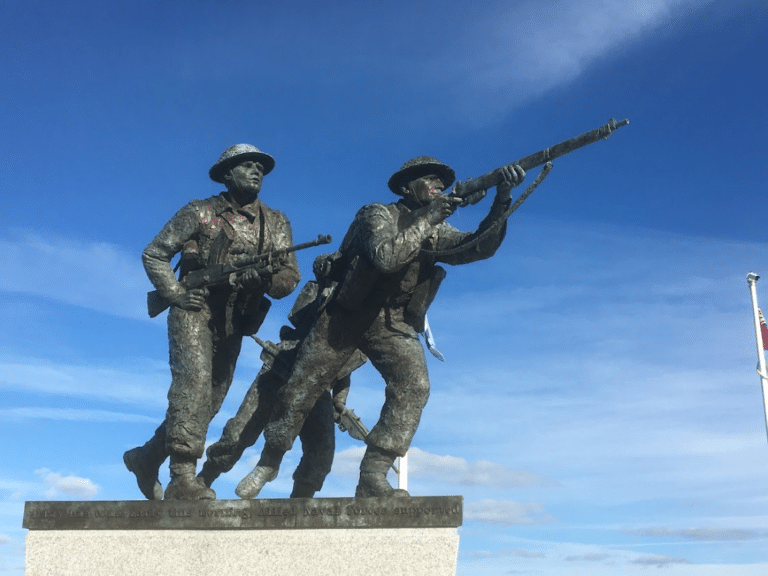D-Day Landing Beaches
Introduction
D-Day took place on Tuesday, 6 June 1944 and was the Allied invasion of Normandy during World War II. Today, the D-Day landing beaches are a key visitor attraction for those wanting to pay their respects.
The events were the start of the liberation of German-occupied France from Nazi control. They laid the foundations for the Allied victory on the Western Front. D-Day was a pivotal point during Operation Overlord and changed the history of Europe. Operation Overlord was the codename for the Battle of Normandy.
Five strategic beachheads were established in Normandy across a 50 mile (80km) stretch of coastline. The five sectors were codenamed Utah, Omaha, Gold, Juno, and Sword. Utah and Omaha beaches were under American leadership, Canadian forces tacked Juno while British troops landed at Gold and Sword.
D-Day Landing Beaches
1. Utah Beach and Sainte-Mère-Église
American troops landed at Utah Beach; the most westerly of the five beaches. The beach stretches from Sainte-Marie-du Mont in the south to Quinéville in the north. The seaborne troops landed south of their intended target and met with very little resistance. There are various sculptures and memorials together with the D-Day Landing Museum (Musée du Débarquement Utah Beach) in Sainte-Marie-du-Mont. Other museums in the area include the D-Day Experience, Dead Man’s Corner Museum, the Normandy Victory Museum and the WW2 Museum at Quinéville. There are also two museums in Sainte-Mère-Église – the Airborne Museum and the Open Air Museum. On the church in Sainte-Mère-Église an effigy of John Steele dangles perilously from the steeple honouring the airborne troops. Don’t miss the stained glass windows in the church. German batteries in the area include the Azeville Gun Battery, Marcouf 44 Command Post and Crisbecq Gun Battery Museum.
Other sites include the US Assualt Landing Craft (Higgins boat) at Carentan, the 1944 Historic Tour of Carentan, the Écausseville Airship Hanger, the Fort of Tatihou and the German military cemetery at Orglandes.
2. Omaha Beach
The villages of Colleville-sur-Mer, Saint-Laurent-sur-Mer and Vierville-sur-Mer are the locations for the majority of the Omaha Beach sites. The Omaha D-Day Museum (Musée D-Day Omaha) is at Vierville-sur-Mer. Liberation House and Omaha Beach Memorial Museum (Musée Memorial d’Omaha Beach) are in Saint-Laurent-sur-Mer. Les Braves sculpture and memorial can be found on the Saint-Laurent beach. The Overlord Museum Omaha Beach and the Big Red One Assault Museum are in Colleville-sur-Mer. The most poignant site is the Normandy American Cemetery and Visitor Centre where over 10,000 soldiers are honoured.
Further along the coast at Grandcamp-Maisy you will find the Peace Statue and the Maisy Gun Battery. La Pointe du Hoc is to the west of Omaha and a strategic point between Omaha and Utah Beaches. You can visit La Pointe du Hoc site and the Visitor Centre to learn about the heroes who fought here. Inland is La Cambe German military cemetery.
3. Gold Beach
The Gold Beach sector stretches east of the port of Arromanches and includes the villages of Asnelles and Ver-sur-Mer. Action was deliberately avoided in Arromanches on D-Day so it could be kept clear for the floating pre-fabricated Mulberry Harbour that was put in place after the invasion. There are three key sites in Arromanches; the 360 circular cinema, the Landings Museum (Musée du Débarquement) and the D-Day Garden. There is a wonderful example of a battery at Longues-sur-Mer. The America Gold Beach Museum (Musée America-Gold Beach) is in Ver-sur-Mer as well as the British Normandy Memorial. Over 600 commonwealth graves are in the Ryes Cemetery in Bazenville.
4. Juno Beach
The beach covers the area including Courseulles, Bernières and Saint-Aubin-sur-Mer. Juno is located between the British beaches of Gold and Sword. The landings at Juno Beach were under Canadian leadership. One of the key sites is the Juno Beach Centre at Courseulles-sur-Mer. The contemporary museum pays homage to the 45,000 Canadians who lost their lives during WW2. Over 2000 Canadian troops are buried at the Bény-sur-Mer cemetery.
5. Sword Beach
Sword Beach is the most easterly of the D-Day beaches stretching west from the Caen Ouistreham ferry port. The original D-Day plan was due to end at Courseulles-sur-Mer. However, the British and American military commanders, Montgomery and Eisenhower, insisted on the front going east as far as the Orne Estuary.
Caen Ouistreham is home to the No. 4 Commando Museum and also the Atlantic Wall Museum. There are also a number of memorials to British troops along the coast west of Ouistreham. Further inland is Hillman Strongpoint at Colleville-Montgomery. The Merville Gun Battery Museum is in Merville-Franceville while the 1944 Radar Museum is in Douvres-La-Déliverande. In Ranville you can visit the Pegasus Bridge and Memorial Museum. There are also Commonwealth war cemeteries at Douvres-La-Déliverande, Hermanville and Ranville.
Other sites include the US Assualt Landing Craft (Higgins boat) at Carentan, 1944 Historic Tour of Carentan, Écausseville Airship Hanger, the Fort of Tatihou and the German military cemetery at Orglandes.






I was planning a trip to Normandy the second week of January. Will there be anything open d-day related at that time?
There will be some D-day sites open such as the cemeteries. The memorials and sculptures including Les Braves and the new British Normandy Memorial are open all year. The Caen Memorial Museum will be closed and won’t re-open until mid to late January. It’s not the best time to visit but it very much depends what you want to see. This might also help you to plan a trip. https://normandygiteholidays.com/a-guide-to-the-d-day-sites